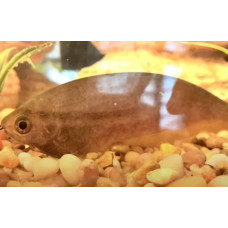Latin name
Xenomystus nigri
Other names
African knifefish
Identification
The body of this fish is unusual: it is flattened ventrolaterally and elongated, giving it a knife blade-like appearance. The scales are extremely fine, giving it a smooth appearance, broken only by a rather prominent lateral line. The lateral line and eyes is the most important sense organ of the fish. The eyes of this fish are large compared to the size of its body. They give the animal excellent night vision. The mouth of the fish is large and it is also equipped with a pair of short antennae that are used for hunting. Body height 5-5.4 x SL, head length 6.9-7.5 x SL, snout smaller than eye, eye diameter 3.8-4.5 x head length, maxilla extending vertically from center of eye or just below back edge of eye, ventral spines 25-32.
Features of fish fins
The caudal and anal fins are fused and extend from the gill opening to the tip of the body, forming a single skirt-like fin. This appendage gives the animal excellent control in the water, allowing it to move back and forth with minimal energy expenditure. The pelvic fins are greatly reduced and not used for locomotion. The dorsal fin is absent. The pectoral fins are long and are designed to give the animal precise control when swimming. They are often used in conjunction with the caudal/anal fin for turning when the fish is hiding in its burrow. Dorsal spines (total): 0; Anal spines: 0; Anal soft rays: 108-130.
Fish colouring
Have a brown body color.
Distribution
Africa: Widespread in tropical Africa, in the Nile, Chad, Niger, Ogowe and Congo river basins. Also found in coastal rivers of Serra Leone, Libya, Togo, Benin and Cameroon, but not in Côte d'Ivoire or Ghana.
Habitat
Freshwater, bottom dwelling, tropical (22°C - 28°C) species. pH range: 6.0 - 8.0. Range dH: 5 - 19. Found in calm waters with vegetation.
Size
The standard length of this fish reaches 30 centimeters (12 inches).
Behavior
The fish is nocturnal and uses the nerve-filled fossa that runs along its body to navigate in water without light. When not hiding, the African Brown Knifefish spends most of its time swimming with its head down and antennae close to the bottom. This species can make barking noises. From time to time they will surface for a breath of air.
Food and feeding habits
The whiskers, combined with its sharp eyesight, help the fish find food. African brown knifefish feed on worms, crustaceans, insects and snails.
Reproduction
Females lay 150-200 eggs 2 mm (0.08 in) in diameter.
Fishing
African brown knifefish are of no interest to fishermen.
Relationship with a person
This species is sometimes found as an aquarium fish. Since this fish is primarily nocturnal, it will avoid bright lights in the aquarium. As they grow larger, these fish may prey on smaller siblings. When young, this fish is good to keep in small groups, as they get older they become a bit aggressive towards their fellow fish.
Interesting facts
The vast majority of fish swim head first, but there are exceptions. The African brown knifefish, or Xenomystus nigri, which lives in the rivers of central Africa, can swim with its tail forward. It has a knife-shaped body with the sides compressed together, no dorsal fins, and only one long, narrow fin running along the entire belly. When hunting, like all fish, it swims with its head forward, but when confronted with an enemy, it immediately "turns on its back" and hides in the thicket.
| Classification | |
| Phylum | Chordata |
| Class | Actinopterygii |
| Squad | Osteoglossiformes |
| Family | Notopteridae |
| Genus | Xenomystus |
| Species | X. nigri |
| Features | |
| Conservation status | No information |
| Habitat | Bottom |
| Life span, years | No information |
| Maximum body weight, kg | No information |
| Maximum length, cm | 30 |
| Sailing speed, m/s | No information |
| Threat to people | Not edible |
| Way of eating | Planktonophage |
African brown knifefish
Tags: african brown knifefish



